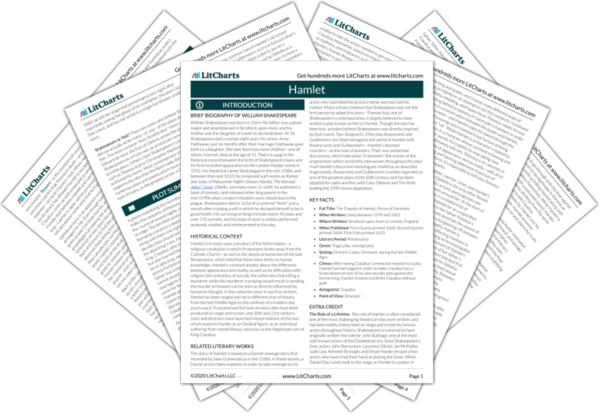Welcome to the LitCharts study guide on William Shakespeare's Hamlet. Created by the original team behind SparkNotes, LitCharts are the world's best literature guides.
Hamlet: Introduction
Hamlet: Plot Summary
Hamlet: Detailed Summary & Analysis
Hamlet: Themes
Hamlet: Quotes
Hamlet: Characters
Hamlet: Symbols
Hamlet: Literary Devices
Hamlet: Quizzes
Hamlet: Theme Wheel
Brief Biography of William Shakespeare

Historical Context of Hamlet
Other Books Related to Hamlet
Key Facts about Hamlet
- Full Title: The Tragedy of Hamlet, Prince of Denmark
- When Written: Likely between 1599 and 1602
- Where Written: Stratford-upon-Avon or London, England
- When Published: First Quarto printed 1603; Second Quarto printed 1604; First Folio printed 1623
- Literary Period: Renaissance
- Genre: Tragic play; revenge play
- Setting: Elsinore Castle, Denmark, during the late Middle Ages
- Climax: After seeing Claudius’s emotional reaction to a play Hamlet has had staged in order to make Claudius face a fictionalized version of his own murder plot against the former king, Hamlet resolves to kill the Claudius without guilt.
- Antagonist: Claudius
- Point of View: Dramatic
Extra Credit for Hamlet
The Role of a Lifetime. The role of Hamlet is often considered one of the most challenging theatrical roles ever written, and has been widely interpreted on stage and screen by famous actors throughout history. Shakespeare is rumored to have originally written the role for John Burbage, one of the most well-known actors of the Elizabethan era. Since Shakespeare’s time, actors John Barrymore, Laurence Olivier, Ian McKellen, Jude Law, Kenneth Branagh, and Ethan Hawke are just a few actors who have tried their hand at playing the Dane. When Daniel Day-Lewis took to the stage as Hamlet in London in 1989, he left the stage mid-performance one night after reportedly seeing the ghost of his real father, the poet Cecil Day-Lewis, and has not acted in a single live theater production since.
Shakespeare or Not? There are some who believe Shakespeare did not actually write many—or any—of the plays attributed to him. The most common “Anti-Stratfordian” theory is that Edward de Vere, the Earl of Oxford, wrote the plays and used Shakespeare as a front man, as aristocrats were not supposed to write plays. Others claim Shakespeare’s contemporaries such as Thomas Kyd or Christopher Marlowe may have authored his works. Most contemporary scholarship, however, supports the idea that the Bard really did compose the numerous plays and poems which have established him, in the eyes of many, as the greatest writer in history.







